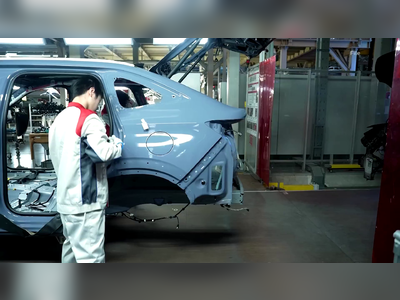Population Decline in Serbia: Statistical Insights from 2011 to 2022
A comprehensive analysis reveals significant demographic shifts and challenges in Serbia's population dynamics.
Between the last two population censuses, Serbia's population decreased by 586,587 individuals, predominantly due to negative natural population growth.
From 2011 to 2022, approximately 470,000 more people died than were born, with the number of emigrants surpassing the number of immigrants by about 117,000.
This amounts to roughly 11,000 more individuals leaving the country each year compared to those immigrating.
The most significant decline occurred in southern Serbia, where the population fell by 417,000 individuals, largely attributed to substantial migration.
Northern Serbia recorded a decrease of nearly 170,000 residents.
Moreover, the natural growth rate variance reveals significantly poorer outcomes in the south, primarily due to unfavorable age-sex structures of migrants over past decades, as noted in a thematic study released by the Republic Statistical Office (RZS), titled "Population of Serbia: Dynamics and Structures," authored by a six-member research team led by Dr. Vladimir Nikitović.
The study indicates that the Belgrade region was the only part of the country that did not experience a decline in population during the inter-census period.
However, this increase was minimal, at just 22,000 individuals, resulting solely from a positive migration balance; more people moved to Belgrade than left.
Vital statistics show that in the capital, there were 50,000 more deaths than births over the eleven-year period, yet 72,000 more immigrants than emigrants, contributing to this slight growth.
In contrast, the regions of Vojvodina, Šumadija, and western Serbia recorded a population decrease of approximately ten percent.
Within Vojvodina, external migration has significantly impacted the population dynamics more than in other regions.
Meanwhile, Šumadija and western Serbia have been more affected by natural population decline.
The most critical situation is in southern and eastern Serbia, where the population decreased by approximately 13 percent from 2011 to 2022.
The authors of the study emphasize that Serbia is facing its third decade of depopulation, with negative natural growth accounting for four-fifths of the overall population decrease.
For over thirty years, Serbia has experienced a scenario where annual deaths exceed births.
Between 2011 and 2022, the number of births ranged from 62,000 to 67,000 annually, while approximately 100,000 individuals died each year.
This trend persisted until 2020, coinciding with the onset of the COVID-19 pandemic, with over 136,000 deaths recorded in 2021.
The vital statistics illustrate that only six municipalities, including Novi Sad and Novi Pazar, reported positive natural growth.
Major urban centers like Belgrade, along with tourist destinations such as Zlatibor and Vrnjačka Banja, have benefited from internal migration.
Conversely, much of Vojvodina, particularly its northern regions, experiences considerable emigration, which adversely affects the overall migration balance.
All regions in Vojvodina, except for South Bačka, are significantly influenced by international migration flows, indicating a greater tendency for emigration compared to other parts of the country.
The study also highlights a dramatic reversal in the gender gap in education between the two population censuses.
Older generations show a higher number of educated men, while among younger cohorts, women achieve higher educational attainment on average.
The disparity between the best and worst educational municipalities exceeds five years of schooling, indicating considerable inequality between urban and rural settings.
Notably, eight of the top ten municipalities in education are in central Belgrade, whereas rural municipalities in the east and southeast rank among the lowest.
Educational pockets exist around major urban centers in central Serbia, such as Kragujevac, Užice, and Čačak, while the population in Vojvodina displays a relatively uniform level of education.
A significant educational gap persists between central and suburban municipalities in Belgrade, influenced by the Bologna reforms on younger generations’ educational structures.
Additionally, data from the RZS study indicate an increase in the number of households in Serbia, yet the average household size has decreased to 2.6 individuals in 2022. There is a notable rise in single-person households, now constituting one-third of all households.
Almost half of elderly households are located in the two southern regions.
Furthermore, families led by married couples, whether with or without children, are decreasing, while the number of single-parent and common-law families is on the rise.
Men continue to predominantly head households in Serbia, with over 60 percent of households recorded in 2022 being associated with male members, albeit with a noticeable downward trend.
From 2011 to 2022, approximately 470,000 more people died than were born, with the number of emigrants surpassing the number of immigrants by about 117,000.
This amounts to roughly 11,000 more individuals leaving the country each year compared to those immigrating.
The most significant decline occurred in southern Serbia, where the population fell by 417,000 individuals, largely attributed to substantial migration.
Northern Serbia recorded a decrease of nearly 170,000 residents.
Moreover, the natural growth rate variance reveals significantly poorer outcomes in the south, primarily due to unfavorable age-sex structures of migrants over past decades, as noted in a thematic study released by the Republic Statistical Office (RZS), titled "Population of Serbia: Dynamics and Structures," authored by a six-member research team led by Dr. Vladimir Nikitović.
The study indicates that the Belgrade region was the only part of the country that did not experience a decline in population during the inter-census period.
However, this increase was minimal, at just 22,000 individuals, resulting solely from a positive migration balance; more people moved to Belgrade than left.
Vital statistics show that in the capital, there were 50,000 more deaths than births over the eleven-year period, yet 72,000 more immigrants than emigrants, contributing to this slight growth.
In contrast, the regions of Vojvodina, Šumadija, and western Serbia recorded a population decrease of approximately ten percent.
Within Vojvodina, external migration has significantly impacted the population dynamics more than in other regions.
Meanwhile, Šumadija and western Serbia have been more affected by natural population decline.
The most critical situation is in southern and eastern Serbia, where the population decreased by approximately 13 percent from 2011 to 2022.
The authors of the study emphasize that Serbia is facing its third decade of depopulation, with negative natural growth accounting for four-fifths of the overall population decrease.
For over thirty years, Serbia has experienced a scenario where annual deaths exceed births.
Between 2011 and 2022, the number of births ranged from 62,000 to 67,000 annually, while approximately 100,000 individuals died each year.
This trend persisted until 2020, coinciding with the onset of the COVID-19 pandemic, with over 136,000 deaths recorded in 2021.
The vital statistics illustrate that only six municipalities, including Novi Sad and Novi Pazar, reported positive natural growth.
Major urban centers like Belgrade, along with tourist destinations such as Zlatibor and Vrnjačka Banja, have benefited from internal migration.
Conversely, much of Vojvodina, particularly its northern regions, experiences considerable emigration, which adversely affects the overall migration balance.
All regions in Vojvodina, except for South Bačka, are significantly influenced by international migration flows, indicating a greater tendency for emigration compared to other parts of the country.
The study also highlights a dramatic reversal in the gender gap in education between the two population censuses.
Older generations show a higher number of educated men, while among younger cohorts, women achieve higher educational attainment on average.
The disparity between the best and worst educational municipalities exceeds five years of schooling, indicating considerable inequality between urban and rural settings.
Notably, eight of the top ten municipalities in education are in central Belgrade, whereas rural municipalities in the east and southeast rank among the lowest.
Educational pockets exist around major urban centers in central Serbia, such as Kragujevac, Užice, and Čačak, while the population in Vojvodina displays a relatively uniform level of education.
A significant educational gap persists between central and suburban municipalities in Belgrade, influenced by the Bologna reforms on younger generations’ educational structures.
Additionally, data from the RZS study indicate an increase in the number of households in Serbia, yet the average household size has decreased to 2.6 individuals in 2022. There is a notable rise in single-person households, now constituting one-third of all households.
Almost half of elderly households are located in the two southern regions.
Furthermore, families led by married couples, whether with or without children, are decreasing, while the number of single-parent and common-law families is on the rise.
Men continue to predominantly head households in Serbia, with over 60 percent of households recorded in 2022 being associated with male members, albeit with a noticeable downward trend.
AI Disclaimer: An advanced artificial intelligence (AI) system generated the content of this page on its own. This innovative technology conducts extensive research from a variety of reliable sources, performs rigorous fact-checking and verification, cleans up and balances biased or manipulated content, and presents a minimal factual summary that is just enough yet essential for you to function as an informed and educated citizen. Please keep in mind, however, that this system is an evolving technology, and as a result, the article may contain accidental inaccuracies or errors. We urge you to help us improve our site by reporting any inaccuracies you find using the "Contact Us" link at the bottom of this page. Your helpful feedback helps us improve our system and deliver more precise content. When you find an article of interest here, please look for the full and extensive coverage of this topic in traditional news sources, as they are written by professional journalists that we try to support, not replace. We appreciate your understanding and assistance.










